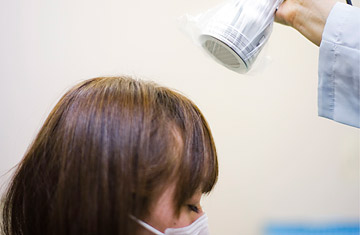
A woman in Yonezawa waits to learn if she has absorbed radiation and if so, how much
(2 of 4)
"This is rewriting the book on nuclear accidents," says physicist Arjun Makhijani, president of the Institute for Energy and Environmental Research in Takoma Park, Md. "It's a combination of earthquake and tsunami causing a lot of damage that's emerging only over the course of days."
The crisis at the Daiichi plant is principally a result of flooding, which inundated emergency power systems and made it impossible to pump needed cooling water to the fuel rods in the reactors. Paradoxically, too much water where they didn't want it resulted in too little where they did. So why didn't the Japanese prepare?
Actually, they did. About 40% of Japan's coastline is protected by seawalls, but near Fukushima, the 33 ft. (10 m) tsunami — a very big one — easily overtopped them. Still, simply because the region flooded didn't mean the diesel-powered generators had to be swamped. Situating them above the waterline could have kept them running. But since the designers assumed the seawall would be sufficient, they put the diesels on the ground floor of the plant. The quake caused grid power to be lost, and within an hour, the generators sputtered to a stop too. "The plant was supposed to have redundant systems to prevent this," says Bergeron. "But if you have four diesels on site and they can all be wiped out at once, that's not real redundancy."
A power-plant blackout is something safety experts train hardest for — and dread the most — because even the best nuclear reactors operate on a thermal knife edge. Each of the six reactors at the Daiichi plant consists of 400 to 760 fuel rods about 14 ft. (4.3 m) in length. They are housed inside a bell jar — like steel and concrete containment vessel, which is protected by a larger, bunkerlike building. Even with coolant constantly bathing the fuel rods, the temperature inside the vessels stays above 500°F (260°C). When the diesels died, the coolant pumps quit. In less than a day, the temperature rose above 2,200°F (1,200°C). That caused the vessels to vent hydrogen, which filled the buildings and led to their sequential explosions: Reactor 1 the day after the quake, Reactor 3 two days later, Reactor 2 the day after that. Reactors 4, 5 and 6 were offline when the quake hit. They needed water too, but since they were cooler to start with, they seemed to present no immediate problem.
Despite all this, Fukushima is no Chernobyl — at least not yet. Chernobyl had no containment vessels, which means that once the external building blew, the radioactive plume blasted out everywhere. What's more, the Chernobyl plant was also used to process plutonium for weapons, making it more susceptible to what nuclear engineers call "neutronic excursion" and what other people call "explosions." Finally, in the moments preceding the Chernobyl accident, operators were, ironically, testing a new safety protocol that spun out of control. "Basically," says Bergeron straightforwardly, "you had idiots running the plant."
But within three days of the quake, the Japanese were starting to look less than brilliant themselves — as was General Electric, the American vendor that designed the Daiichi reactors. The Mark 1, the GE model that was popular in 1971, when the plant went into service, has been criticized for having less robust containment vessels than other plants of that era.
That may be so, but its more immediate shortcoming is a design feature it shares with other older reactors. In all those systems, spent fuel rods are stored in a pool inside the concrete reactor building for at least 10 years before being transferred to long-term storage. As long as water circulates constantly, the pools remain stable. But when power is lost, the circulation stops. And when the roof blows off, the pools are exposed to the air. Add the heat generated by the rods, and the water starts to boil away. "If you don't cool the spent fuel, there may be a swift chain reaction that leads to spontaneous combustion, an explosion and fire," says research scientist Ferenc Dalnoki-Veress of the James Martin Center for Nonproliferation Studies in Monterey, Calif.
